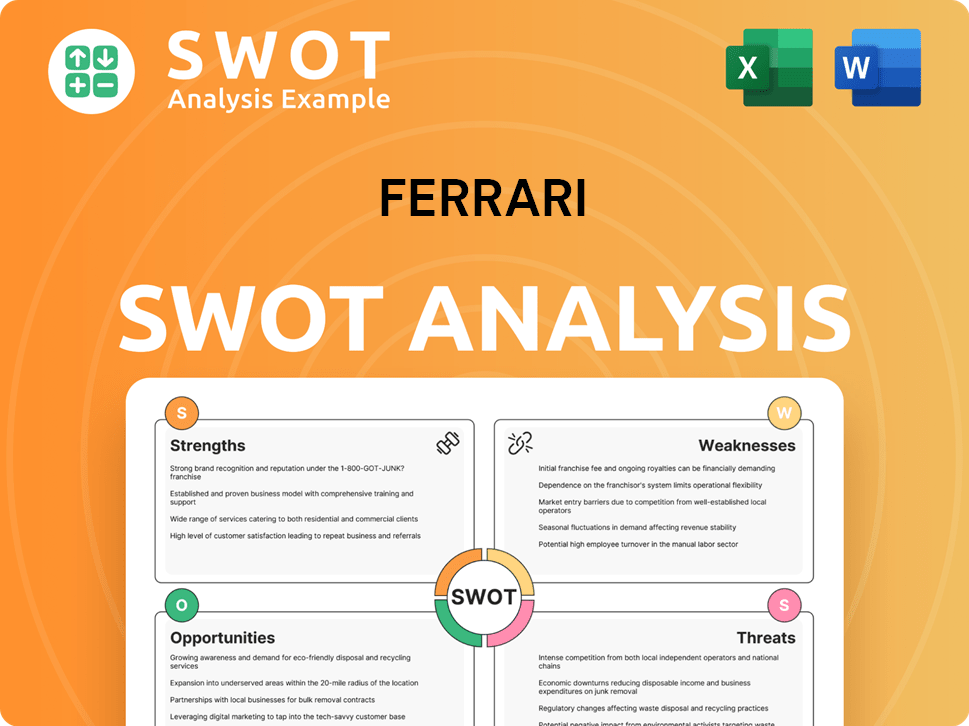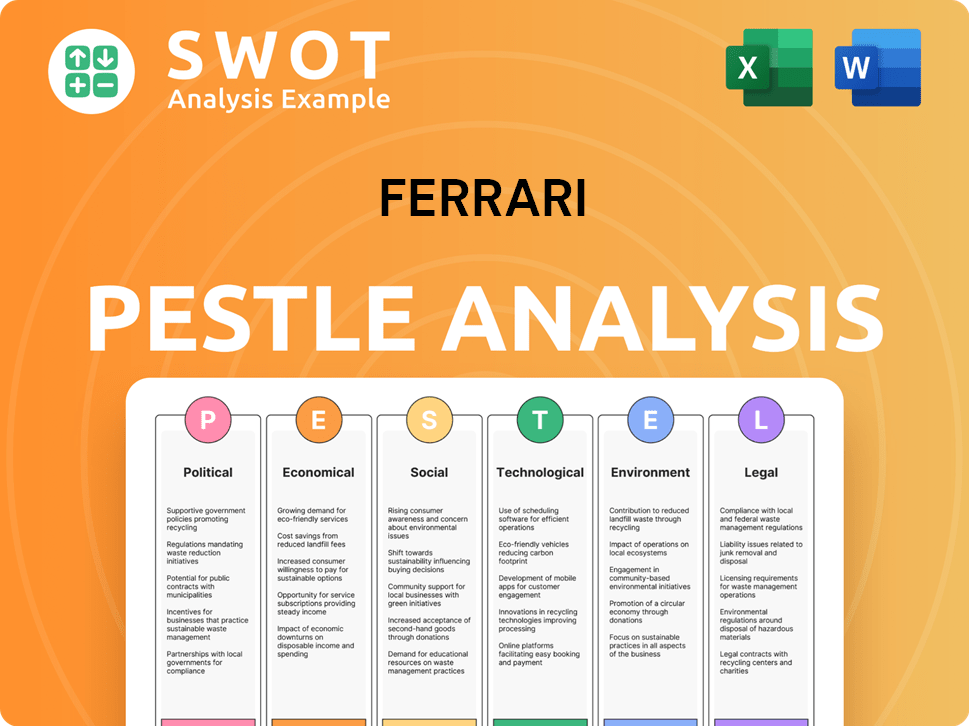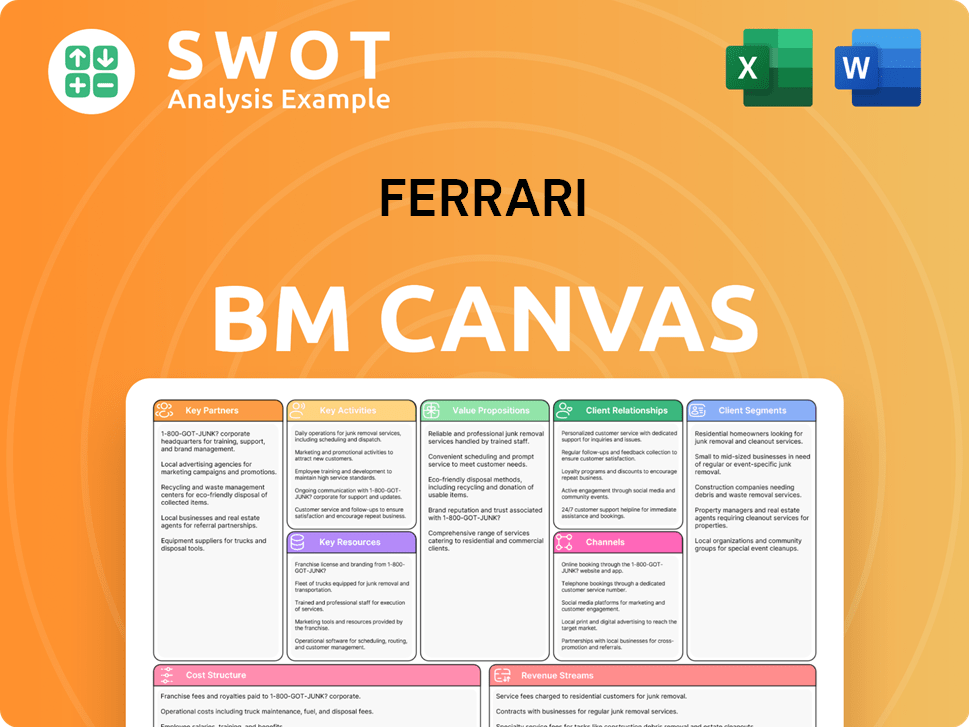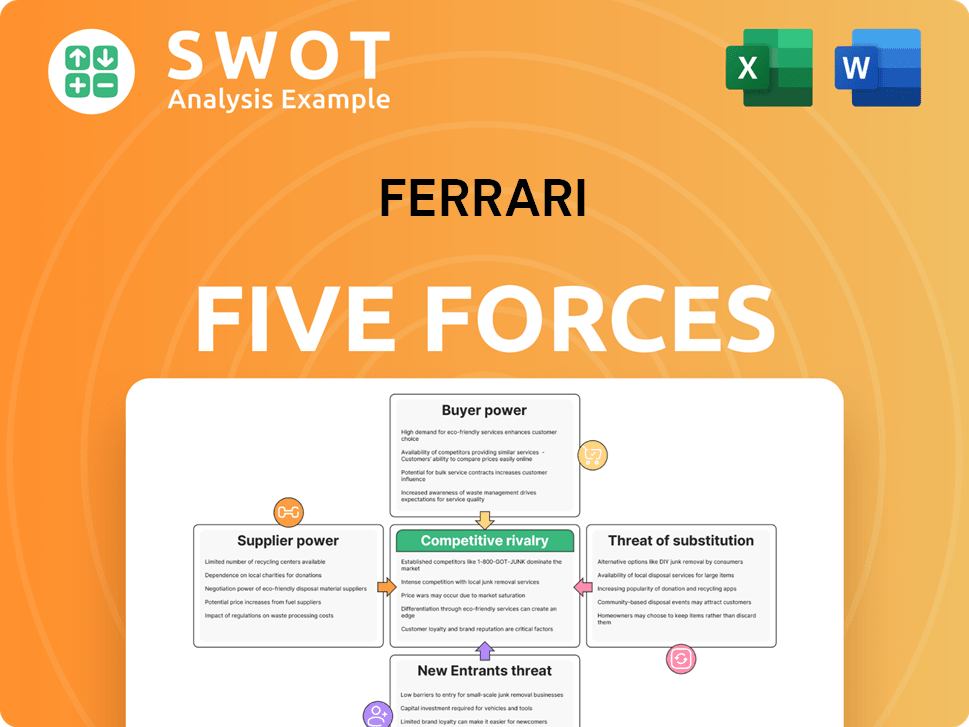Ferrari Bundle
Who Really Calls the Shots at Ferrari?
Unraveling the intricate web of Ferrari SWOT Analysis ownership is key to understanding the future of this legendary brand. From its humble beginnings to its current status as a global luxury icon, Ferrari's journey has been shaped by a series of significant ownership changes. This exploration delves into the individuals and entities that have controlled Ferrari, influencing its strategic direction, brand image, and financial performance.

Understanding the Ferrari ownership structure, including the Ferrari owner and Ferrari parent company history, offers invaluable insights into the company's governance and future strategies. Discover the evolution of Ferrari's company structure, from its origins with Enzo Ferrari to its current status as a publicly traded entity. Explore the influence of major stakeholders and how this complex landscape impacts the company's ability to innovate and maintain its premium brand positioning. The Ferrari history reveals a fascinating narrative of strategic partnerships, financial maneuvers, and the enduring legacy of a brand synonymous with speed and luxury.
Who Founded Ferrari?
The story of Ferrari's ownership begins with its founder, Enzo Ferrari. He established the racing team Scuderia Ferrari in 1929, initially racing Alfa Romeo cars. The first car bearing the Ferrari name, the 125 S, was produced in 1947, marking the official start of the manufacturing company.
During the early years, Enzo Ferrari maintained complete control over the company. This reflected his vision for both racing and road car production. As the company grew, the need for external investment became apparent, especially to support its ambitious racing endeavors.
In 1969, Fiat S.p.A. acquired a 50% stake in Ferrari. This was a pivotal moment, providing much-needed capital. Enzo Ferrari retained significant control over Scuderia Ferrari and maintained influence over road car operations.
Enzo Ferrari founded Scuderia Ferrari in 1929. This racing team initially used Alfa Romeo cars. The first Ferrari-badged car was produced in 1947.
Enzo Ferrari had complete control in the beginning. He oversaw both racing and road car production. This ensured his vision was followed.
Fiat acquired a 50% stake in 1969. This provided much-needed financial support. Enzo Ferrari retained significant influence.
The partnership with Fiat was strategic. It ensured financial stability for Ferrari. It allowed for continued development.
Other early backers are not widely publicized. The Fiat acquisition was the most significant change. It shaped the company's future.
There were no widely reported disputes before Fiat's involvement. This ensured a smooth transition. It maintained the founder's influence.
The initial Ferrari's history involved Enzo Ferrari's sole ownership. Fiat's investment in 1969 was a major shift in Ferrari's ownership structure. The initial partnership with Fiat was crucial for financial stability. The Ferrari parent company is now part of a larger group.
- Enzo Ferrari founded the company and maintained control initially.
- Fiat's 50% stake in 1969 was a significant change.
- The Fiat deal provided capital for racing and road car development.
- Early ownership changes were primarily centered on Enzo Ferrari's control.
Ferrari SWOT Analysis
- Complete SWOT Breakdown
- Fully Customizable
- Editable in Excel & Word
- Professional Formatting
- Investor-Ready Format

How Has Ferrari’s Ownership Changed Over Time?
The evolution of Ferrari's ownership is a story of strategic shifts and significant milestones. Initially, the company's control moved from Enzo Ferrari to Fiat, with Fiat acquiring a 50% stake in 1969. Over time, Fiat increased its ownership, reaching 90% by 1988. This period marked a crucial step in integrating the iconic brand into a larger automotive group while preserving its unique identity.
A pivotal change occurred on October 21, 2015, when Ferrari launched its Initial Public Offering (IPO) on the New York Stock Exchange (NYSE) under the ticker symbol 'RACE.' The IPO priced shares at $52 each, valuing the company at approximately $9.8 billion. This strategic move by Fiat Chrysler Automobiles (FCA) aimed to unlock the value of its luxury brands, eventually leading to Ferrari's independence. FCA distributed its remaining stake to its shareholders, effectively spinning off Ferrari as a separate entity.
| Ownership Event | Date | Details |
|---|---|---|
| Fiat Acquires Stake | 1969 | Fiat acquired 50% of Ferrari. |
| Fiat Increases Stake | By 1988 | Fiat held 90% of Ferrari. |
| Initial Public Offering (IPO) | October 21, 2015 | Ferrari listed on NYSE (RACE) at $52 per share. |
Currently, the ownership structure of Ferrari N.V. is diverse. Exor N.V., the Agnelli family's holding company, is the largest shareholder, holding approximately 24.3% of ordinary shares as of early 2024, and about 36.2% of the voting rights. Piero Ferrari, Enzo Ferrari's son, holds approximately 10.2% of the ordinary shares and about 15.3% of the voting rights. The remaining shares are publicly traded, held by institutional investors, mutual funds, and individual shareholders. This structure balances public market participation with family and strategic control, ensuring the company's heritage and strategic direction remain intact. As of Q1 2024, the company's market capitalization was around $75 billion.
The ownership of Ferrari has evolved significantly over time, from its early days to its current structure.
- Exor N.V. is the largest shareholder, ensuring significant control.
- Piero Ferrari, Enzo Ferrari's son, maintains a substantial stake.
- The majority of shares are publicly traded, offering investment opportunities.
- The IPO in 2015 marked a pivotal moment in Ferrari's history.
Ferrari PESTLE Analysis
- Covers All 6 PESTLE Categories
- No Research Needed – Save Hours of Work
- Built by Experts, Trusted by Consultants
- Instant Download, Ready to Use
- 100% Editable, Fully Customizable

Who Sits on Ferrari’s Board?
The Board of Directors of Ferrari N.V. is pivotal in the company's governance, reflecting its varied ownership. As of early 2025, the board typically includes representatives from major shareholders, independent directors, and executive management. John Elkann, the Chairman of Exor N.V., chairs Ferrari, connecting the largest shareholder to the company's leadership. Piero Ferrari serves as Vice Chairman, ensuring the founding family's continued influence.
The board's composition aims to balance the interests of major shareholders with independent oversight. The presence of independent directors is intended to provide objective oversight and represent the interests of all shareholders. However, the significant voting power held by Exor and Piero Ferrari means they exert substantial influence over strategic decisions, executive appointments, and other key corporate actions. There have been no widely reported recent proxy battles or activist investor campaigns that have significantly challenged this established voting structure.
| Board Member | Role | Affiliation |
|---|---|---|
| John Elkann | Chairman | Exor N.V. |
| Piero Ferrari | Vice Chairman | Founding Family |
| Independent Directors | Various | Independent |
Ferrari employs a loyalty voting mechanism. This mechanism grants shareholders who have held their shares for at least three years additional voting rights. This dual-class share structure significantly amplifies the voting power of long-term shareholders like Exor N.V. and Piero Ferrari. For instance, while Exor N.V. holds around 24.3% of the ordinary shares, its voting power is approximately 36.2% due to these loyalty shares. Similarly, Piero Ferrari's 10.2% shareholding translates to approximately 15.3% of the voting rights. This structure ensures that the major stakeholders maintain significant control over the company's direction. To understand more about the company's past, you can read about the history of Ferrari ownership.
The board is a mix of shareholder representatives, independent directors, and executives. John Elkann, from Exor N.V., is the Chairman, and Piero Ferrari is the Vice Chairman.
- Exor N.V. holds a significant portion of voting power.
- Loyalty voting gives long-term shareholders more control.
- Independent directors provide oversight.
- The voting structure hasn't faced recent challenges.
Ferrari Business Model Canvas
- Complete 9-Block Business Model Canvas
- Effortlessly Communicate Your Business Strategy
- Investor-Ready BMC Format
- 100% Editable and Customizable
- Clear and Structured Layout

What Recent Changes Have Shaped Ferrari’s Ownership Landscape?
Over the past few years, the Ferrari ownership landscape has remained relatively consistent. The major stakeholders include Exor N.V. and Piero Ferrari, maintaining their significant influence. While there haven't been major shifts in the core ownership percentages, the company has demonstrated consistent performance and strategic initiatives to strengthen its position in the luxury market. Ferrari's focus on expanding its product range with new models, including hybrid vehicles, and upholding its exclusivity through limited production runs, has been a key strategy.
A notable trend in the automotive and luxury sectors is the increasing emphasis on sustainability and electrification. This doesn't directly alter ownership percentages. However, it influences strategic investments and partnerships. These actions can indirectly affect the company's valuation and appeal to various investor types. Ferrari's commitment to developing electric vehicles, as outlined in its strategic plans, represents a significant development. This could attract new categories of environmentally conscious investors in the future. The company's strategic moves are well-documented in articles like the Marketing Strategy of Ferrari.
| Key Ownership Aspects | Details | Recent Trends |
|---|---|---|
| Major Shareholders | Exor N.V., Piero Ferrari | Stable ownership percentages; no significant changes. |
| Strategic Focus | Product portfolio expansion, including hybrid vehicles; maintaining exclusivity. | Emphasis on sustainability and electrification; potential for new investor categories. |
| Market Dynamics | Strong demand in the luxury market; increased institutional ownership. | Consistent profitability and cash flow, allowing for potential future actions like share buybacks. |
The luxury market's robust demand continues to benefit Ferrari. Industry trends also show increased institutional ownership in stable, high-performing luxury brands. This is because they are seen as resilient investments during economic fluctuations. While there have been no large-scale share buybacks or secondary offerings that significantly altered the ownership structure in recent years, Ferrari's consistent profitability and strong cash flow could allow for such actions in the future. Public statements by the company and analysts highlight Ferrari's commitment to its unique brand identity and carefully managed growth. This suggests that major ownership changes, such as privatization or significant founder dilution, are unlikely in the near term, given the current stable and effective control structure.
Ferrari is primarily controlled by Exor N.V., a publicly traded company. Piero Ferrari, son of the founder, also holds a significant stake. The company's structure reflects a blend of public and family ownership.
Exor N.V. is the primary owner of Ferrari. Piero Ferrari also has a substantial ownership share. The remaining shares are held by public investors.
Ferrari's parent company is Exor N.V. Exor N.V. is a diversified holding company. It has a significant stake in Ferrari.
The major shareholders include Exor N.V. and Piero Ferrari. A significant portion of the shares is publicly traded. This allows for diverse investor participation.
Ferrari Porter's Five Forces Analysis
- Covers All 5 Competitive Forces in Detail
- Structured for Consultants, Students, and Founders
- 100% Editable in Microsoft Word & Excel
- Instant Digital Download – Use Immediately
- Compatible with Mac & PC – Fully Unlocked

Related Blogs
- What are Mission Vision & Core Values of Ferrari Company?
- What is Competitive Landscape of Ferrari Company?
- What is Growth Strategy and Future Prospects of Ferrari Company?
- How Does Ferrari Company Work?
- What is Sales and Marketing Strategy of Ferrari Company?
- What is Brief History of Ferrari Company?
- What is Customer Demographics and Target Market of Ferrari Company?
Disclaimer
All information, articles, and product details provided on this website are for general informational and educational purposes only. We do not claim any ownership over, nor do we intend to infringe upon, any trademarks, copyrights, logos, brand names, or other intellectual property mentioned or depicted on this site. Such intellectual property remains the property of its respective owners, and any references here are made solely for identification or informational purposes, without implying any affiliation, endorsement, or partnership.
We make no representations or warranties, express or implied, regarding the accuracy, completeness, or suitability of any content or products presented. Nothing on this website should be construed as legal, tax, investment, financial, medical, or other professional advice. In addition, no part of this site—including articles or product references—constitutes a solicitation, recommendation, endorsement, advertisement, or offer to buy or sell any securities, franchises, or other financial instruments, particularly in jurisdictions where such activity would be unlawful.
All content is of a general nature and may not address the specific circumstances of any individual or entity. It is not a substitute for professional advice or services. Any actions you take based on the information provided here are strictly at your own risk. You accept full responsibility for any decisions or outcomes arising from your use of this website and agree to release us from any liability in connection with your use of, or reliance upon, the content or products found herein.